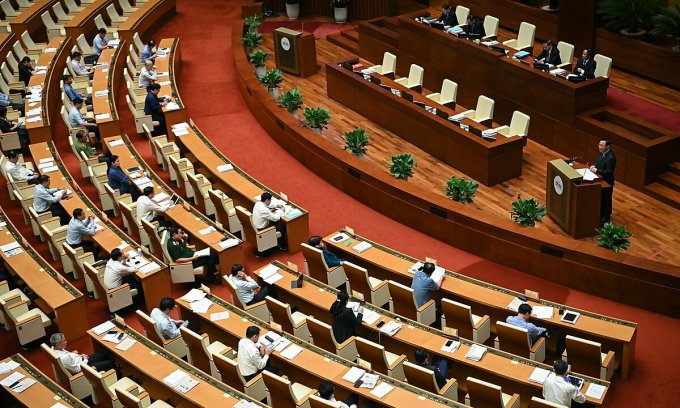Environmental protection costs in construction in Vietnam

Under the regulations of current law, an environmental fee is a fee that producers or consumers pay because their activities or products they use have an adverse effect on the environment. The State will use this fee to protect and improve the environment. So about the matter “Environmental protection costs in construction in Vietnam” Let’s find out with LSX in the article below.
Legal grounds
- Decree No. 164/2016/ND-CP
What is the cost of environmental protection?
In general, the current legal documents or sub-law documents do not have a detailed regulation to define what the environmental protection fee is. However, in the common sense, we will understand that the environmental protection fee is an amount of money that an individual or organization discharges into the environment or generates negative impacts on the environment to pay in order to basically compensate. cost and service nature when a competent state agency provides services for environmental protection, construction and maintenance activities. At the same time, organize the State’s administrative management of taxpayers’ activities.
This is considered a mandatory fee for individuals or legal entities to enjoy a benefit or use a certain environmental service.
Environmental fee in English is: Environment fee
Which activities must pay environmental protection fees?
In Clause 2, Article 136 of the Law on Environmental Protection 2020, there are regulations on environmental protection fees as follows:
– Environmental protection fees apply to activities of discharge into the environment; mining minerals or giving rise to adverse impacts on the environment; public services in the field of environmental protection in accordance with the law on fees and charges;
Thus, the environmental protection fee is applied to organizations and individuals that have activities of discharging waste, exploiting minerals, activities that generate adverse impacts on the environment, public services in the field of environmental protection according to regulations.
In addition, the Law also stipulates that the environmental protection fee shall be determined on the basis of the volume and level of toxicity of the pollutant discharged into the environment, and the characteristics of the waste receiving environment; the degree of adverse impact on the environment of mineral mining activities; nature of public services in the field of environmental protection;
Environmental protection costs in construction in Vietnam
Current regulations do not include environmental protection tax costs while making construction estimates. Environmental protection fee is another expense in case of self-exploiting materials and fuel.
The form of report on construction design verification results is provided in Appendix I to Decree No. 15/2021/ND-CP dated March 3, 2021 of the Government detailing a number of contents on construction investment project management. There is no content to evaluate the capacity of surveying and design consulting units.
However, the verification and assessment of the capacity of the units and individuals conducting the survey and the design consultancy is necessary to ensure the prescribed capacity conditions before carrying out the verification contents. according to the law.
How to calculate environmental protection costs in construction
Pursuant to Article 5 of Decree No. 164/2016/ND-CP, the method of calculating environmental protection fee is as follows:
– The environmental protection fee for mineral extraction payable in the fee payment period is calculated according to the following formula:
F = [(Q1 x f1) + (Q2 x f2)] x K
In there:
+ F is the amount of environmental protection fee payable in the period;
+ Q1 is the amount of soil and rock discharged during the payment period (m3);
+ Q2 is the quantity of raw mineral ores exploited in the period (tons or m3);
+ f1 is the fee for the amount of soil and rock removed: 200 VND/m3;
+ f2 is the corresponding fee for each type of mineral extracted (VND/ton or VND/m3);
– K is the charging coefficient according to the mining method, where:
++ Open-pit mining (including mining by water power such as mining titanium, sand, gravel in river bed): K = 1.1;
++ Underground mining and other forms of exploitation (crude oil, natural gas, natural mineral water and the rest): K = 1.
– For the amount of soil and rock discharged during coal mining, no fee will be charged until the end of 2017.
– The quantity of soil and rock discharged (Q1) in the fee payment period is determined based on the documents of the mining construction investment project approved by the competent state agency or according to the report. environmental impact assessment reports and related documents approved by competent state agencies.
The amount of charge payable for the quantity of soil and rock discharged during the fee payment period is based on the volume of excavated soil and rock calculated on the volume (tons or m3) of raw mineral ores exploited in the period.
If there is no information on the quantity of soil and rock discharged, the declaration and submission of the mining construction investment project documents, the environmental impact assessment report and related documents in the construction investment project document, the environmental impact assessment report and related documents. The fee is based on the actual amount of excavated soil and rock discharged in the period.
– The quantity of minerals exploited in the period to determine the payable environmental protection fee is the quantity of raw minerals actually exploited in the fee payment period (Q2). In the case of mining minerals that must be screened, selected, classified and enriched before being sold and other cases where it is necessary to convert, based on actual mining conditions and mineral processing technology in the locality. At the table, the Department of Natural Resources and Environment shall assume the prime responsibility for, and coordinate with the local Tax Department in, submitting to the People’s Committee of the province for decision the conversion ratio from the quantity of finished minerals to the quantity of primary minerals as a basis for calculating environmental protection fees for each type of mineral to suit the actual situation of the locality.
– In case, during the mining process, another type of mineral of the licensed mineral is obtained, the fee payer must pay the environmental protection fee for mineral ores (Q2) at the rate of the type of mineral licensed. competent state agencies to issue mining licenses.
– In case organizations and individuals exploiting stone for fine arts in a large block, the fee rates specified at Point 2, Section II of the fee schedule attached to this Decree shall apply.
– In case an organization or individual exploits minerals for use as common construction materials in the residential land area under the land use right of households and individuals to construct works of households and individuals in the that area and in case land and stone are exploited for leveling, construction of security and military works, natural disaster prevention and control, natural disaster recovery and mitigation, no environmental protection fee shall be paid for mining. that mineral.
Thus, in order to calculate the environmental protection fee for mining construction stone, the output of construction stone must be calculated. Accordingly, the output used to determine the payable environmental protection fee is the actual quantity of raw minerals exploited in the fee payment period (Q2). In the case of mining minerals that must be screened, selected, classified and enriched before being sold and other cases where it is necessary to convert, based on actual mining conditions and mineral processing technology in the locality. At the table, the Department of Natural Resources and Environment shall assume the prime responsibility for, and coordinate with the local Tax Department in, submitting to the People’s Committee of the province for decision the conversion ratio from the quantity of finished minerals to the quantity of primary minerals as a basis for calculating environmental protection fees for each type of mineral to suit the actual situation of the locality.
How to declare and pay environmental protection expenses in construction?
1. Organizations and individuals exploiting minerals must submit environmental protection fee declaration dossiers to the tax authorities directly managing the same place where natural resources tax is declared and paid. In case there is no environmental protection fee for mineral exploitation in a month, the fee payer must still declare and submit a fee payment declaration to the tax office. In case the mineral-collecting organization must register to pay on behalf of the miner, that organization shall submit the environmental protection fee declaration dossier to the tax agency managing the mineral-purchasing establishment. The deadline for declaring the environmental protection fee to the tax agency is the 20th day of the following month.
2. The environmental protection fee for mineral exploitation is declared monthly and settled annually. Finalization of environmental protection fees for mining includes annual finalization and finalization up to the time of termination of mineral mining activities, termination of mineral collection and purchase activities, and termination of operations, terminate the contract to transform the form of enterprise ownership or reorganize the enterprise.
3. In case the fee payer is subject to the fixed amount of payable fee, the provisions of the Law on Tax administration and guiding documents shall be complied with.
4. The place to declare and pay the environmental protection fee for crude oil, natural gas and coal gas is the local Tax Department where the main administrative office is located.
5. The currency for payment of environmental protection fees for mineral exploitation is Vietnam dong.
6. In addition to the above provisions, the declaration, payment, and settlement of environmental protection charges for mineral exploitation shall comply with the provisions of the Tax Administration Law and guiding documents on the implementation of the Law on Management of Minerals.
Services of LSX
Prestigious professional services: Firstly, the team of consultants and consultants for many years in the field of civil status, and customer support.
On-time: Certainly, with the motto “Get your lawyer right at your fingertips”, we ensure the service always performs on time. The rights and interests of customers always come first.
Cost: Besides, LSX’s service costs are highly competitive; depending on the nature of the particular case. So, we want our guests to have the best possible service experience. Therefore, costs which guaranteed to be the most suitable and economical for customers.
Confidentiality of client information: Finally, all brand information of client LSX will be 100% confidential.
Please contact us immediately if you have any questions about “Environmental protection costs in construction in Vietnam”
Contact LSX
Finally, hopefully the information in the article will provide helpful information for readers and help you solve the problem “Environmental protection costs in construction in Vietnam” At the same time, LSX Law firm always has leading lawyers and legal consultants who will help you in legal matters of life. If you have any need, please get in touch with us via hotline: +84846175333 or Email: [email protected]
Please see more
- Environmental protection tax incentives in Vietnam
- Environmental crimes are regulated in which Vietnam law?
- Proving separate property before marriage under Vietnam law
Frequently asked questions
The following cases shall apply toll rates for salvage mineral exploitation.
a) Mining activities remaining in the waste dump of the mine have had a decision to close the mine;
b) Production and business activities of organizations and individuals that do not have the purpose of mining minerals, but have functions and tasks or have business registration, in the course of operation according to their functions, tasks or according to the registered specialty that obtained minerals.
c) In other cases not specified at Points a and b of this Clause, the fee rate applicable to salvaged mineral extraction shall not be applied.
Expenses for environmental protection for the exploitation of minerals in construction are regulated as follows:
Environmental protection fee for crude oil: 100,000 VND/ton; for natural gas, coal gas: 50 VND/m3. Particularly for natural gas obtained in the process of crude oil extraction (companion gas): 35 VND/m3.
The environmental protection fee rate bracket for other mineral extraction according to the fee bracket schedule attached to this Decree.
The environmental protection fee for salvaged mineral exploitation is equal to 60% of the fee for the corresponding mineral specified in the fee schedule attached to this Decree.
Pursuant to Clause 2, Article 2 of Decree 49/2016/ND-CP on fines as follows
A warning will be imposed for failure to comply with the notice of payment of fees and charges issued by the competent authority.
A fine of from 1 to 3 times the amount of fees and charges for fraud or evasion of payment for acts of fraud or evasion of payment of fees and charges as prescribed. The maximum fine is VND 50,000,000.
Remedial measures: Forcing violators to pay the full amount of fees and charges for fraud or evasion
Thus, the act of not paying the environmental protection fee will be penalized. Depending on the type of penalty, there will be different specific penalties.
Conclusion: So the above is Environmental protection costs in construction in Vietnam. Hopefully with this article can help you in life, please always follow and read our good articles on the website: lsxlawfirm.com




